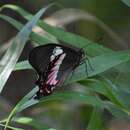Parides ascanius, the Fluminense swallowtail, is a species of butterfly in the family Papilionidae. It is endemic to Brazil where it is confined to the municipalities of Atafona (São João da Barra) and Itaguaí.
Description
Parides ascanius has a spatulate tail. The two sexes are similar. The male has on the hindwing a hindmarginal fold, covered with white wool. A broad white band traverses both wings; on the hindwing it is more or less red. The larva is light brown, and bears pointed tubercles on all the segments. A full description is provided by Rothschild, W. and Jordan, K. (1906)[3]
Biology
Parides ascanius larvae are found from October to April, feeding only on Aristolochia macroura in its preferred wetland habitats. Adults fly all year. The favourite flower of the nectar feeding adults is Lantana camara (Verbenaceae) [4]
Taxonomy
Parides ascanius is a member of the ascanius species group[5][6]
The members are
Etymology
It is named in the classical tradition. In Roman mythology Ascanius is a legendary king. The common name, "Fluminense", is the demonym for residents of the state of Rio de Janeiro, Brazil.
Sources
References
-
^ Grice, H.; Freitas, A.V.L.; Rosa, A.; Marini-Filho, O.; Mega, N.; Dias, F.M.S.; Mielke, O.; Casagrande, M. (2019). "Parides ascanius". IUCN Red List of Threatened Species. 2019: e.T16239A145165808. doi:10.2305/IUCN.UK.2018-2.RLTS.T16239A145165808.en. Retrieved 15 November 2021.|date= / |doi= mismatch
-
^ Cramer, P. De uitlandsche Kapellen voorkomende in de drie Waereld-Deelen Asia, Africa en America. I. Deel. Beschriving van Plaat I-XCVI. Papillons exotiques des trois parties du monde l'Asie, l'Afrique et l'Amérique. Tome premier. Description des planches I-XCVI., Cramer, P. ([1775]) De uitlandsche Kapellen voorkomende in de drie Waereld-Deelen Asia, Africa en America. I. Deel. Beschriving van Plaat I-XCVI. Papillons exotiques des trois parties du monde l'Asie, l'Afrique et l'Amérique. Tome premier.
-
^ Rothschild, W. and Jordan, K. (1906). A revision of the American Papilios. Novitates Zoologicae 13: 411-752. (Facsimile edition ed. P.H. Arnaud, 1967) and online
-
^ Seitz, A. ed. Band 1: Abt. 1, Die Großschmetterlinge des palaearktischen Faunengebietes, Die palaearktischen Tagfalter, 1909, 379 Seiten, mit 89 kolorierten Tafeln (3470 Figuren)
 This article incorporates text from this source, which is in the public domain.
This article incorporates text from this source, which is in the public domain. -
^ Möhn, Edwin (2006). Schmetterlinge der Erde, Butterflies of the World Part XXVI (26), Papilionidae XIII. Parides. Edited by Erich Bauer and Thomas Frankenbach Keltern: Goecke & Evers; Canterbury: Hillside Books. ISBN 978-3-937783-27-7 (Supplement 13 in English - by Racheli)
-
^ Racheli, Tommaso an Olmisani. Luca 1998. A cladistic analysis of the genus Parides Hubner, [1819], based on androconial structures (Lepidoptera: Papilionidae). Neue Ent. Nachr. (Marktleuthen),41:119-131.pdf

